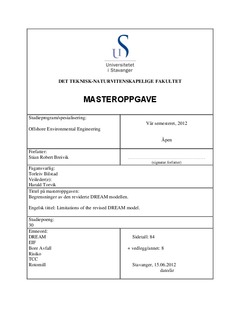| dc.contributor.author | Breivik, Stian | |
| dc.date.accessioned | 2012-09-18T11:50:45Z | |
| dc.date.available | 2012-09-18T11:50:45Z | |
| dc.date.issued | 2012 | |
| dc.identifier.uri | http://hdl.handle.net/11250/182511 | |
| dc.description | Master's thesis in Environmental Technology | no_NO |
| dc.description.abstract | DREAM (Dose-related Risk and Exposure Assessment Model) is a risk assessment tool for
modeling offshore waste discharge to the marine environment. The drilling waste model was
developed through the joint industrial project ERMS (Environmental Risk Management System).
The method follows a PEC/PNEC (Predicted Environmental Concentration / Predicted no Effect
Concentration) approach as to determine an EIF (Environmental Impact Factor) for the sediment
and water column.
The scope of this study was to identify the models limitations for a scenario where drilling waste
(cuttings & mud) treated by a TCC (Thermeochemical Cutting Cleaner) unit was discharged to
the marine environment. The TCC unit pulverizes oil contaminated cuttings, creating enough
heat to vaporize the drilling fluids. The effluent is assumed to contain approximately 0.1 % oil
(w/w). Consequently, the main impact from the discharge will be from the drilled cuttings and
weighing materials such as barite. The model was assessed through a Planckett-Burman DOE (Design of Experiment) as to identify
the most significant model parameters. 17 model parameters were evaluated in 50 simulations.
The stability (Goodness of Fit) of the model was evaluated through a least square root multiple
regression analysis. This combined with a literature review formed the basis for discussion and
conclusions. The revised DREAM model is subjected to several assumptions and simplifications. The model
is rather complex with substantial variables that may be difficult to standardize or predict. This
has resulted in a tool for comparing environmental risk based on different management options.
While the model estimated risk has limited relations with the actual consequence of a discharge,
it may however shed some light on impact differences between discharge scenarios.
The effluent from the TCC unit may be modeled comparatively in DREAM if some adjustments
are made. It is necessary to obtain a representative particle size distribution of the effluent as to
predict the fate. The distribution should also have an associated PNEC value for each size
interval as to account for non-toxic interactions from cuttings and weight material such as barite. | no_NO |
| dc.language.iso | eng | no_NO |
| dc.publisher | University of Stavanger, Norway | no_NO |
| dc.relation.ispartofseries | Masteroppgave/UIS-TN-IMN/2012; | |
| dc.subject | teknisk miljøvern | no_NO |
| dc.subject | DREAM | no_NO |
| dc.subject | rotomill | no_NO |
| dc.subject | boreavfall | no_NO |
| dc.subject | risiko | no_NO |
| dc.subject | TCC | no_NO |
| dc.subject | EIF | no_NO |
| dc.subject | Dose-related Risk and Exposure Assessment Model | no_NO |
| dc.title | Limitations of the Revised DREAM Model | no_NO |
| dc.type | Master thesis | no_NO |
| dc.subject.nsi | VDP::Mathematics and natural science: 400 | no_NO |
| dc.source.pagenumber | 92 | no_NO |
